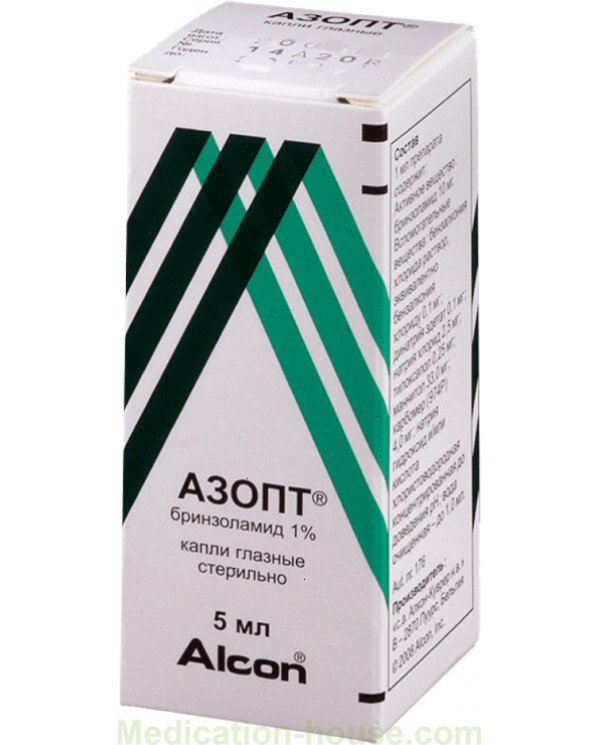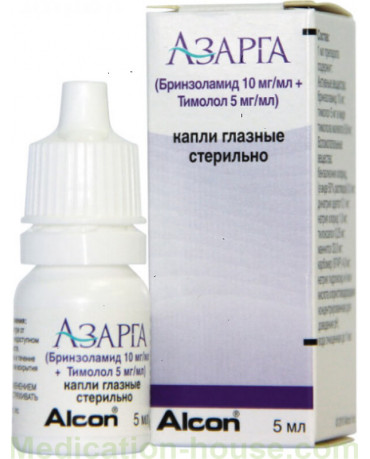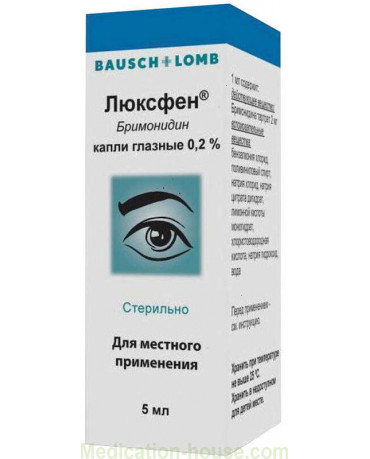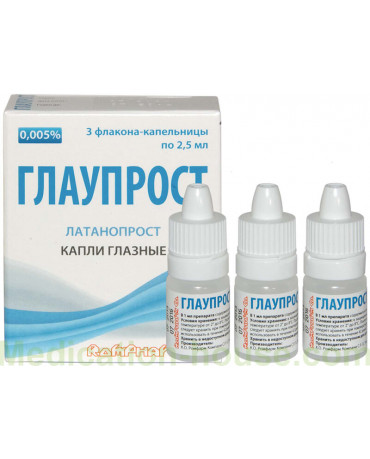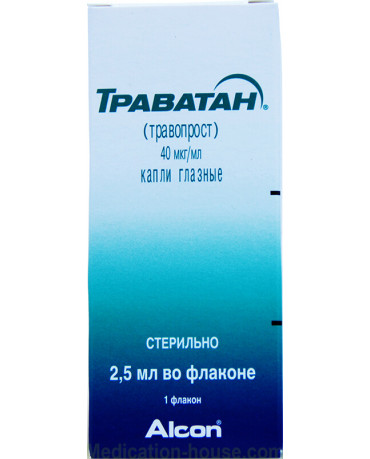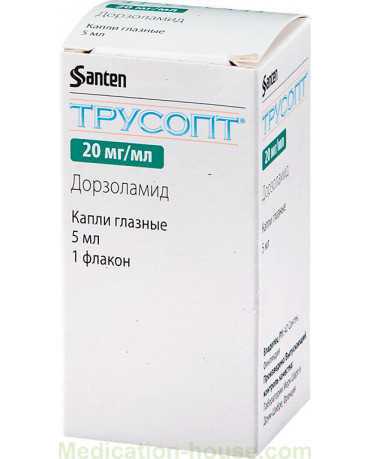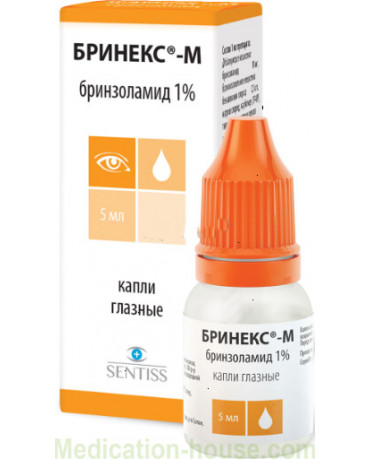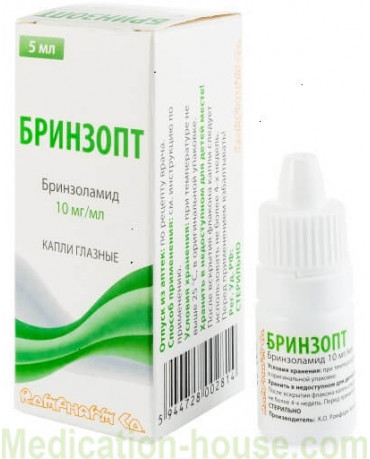Instruction for Azopt
Reed more and buy Azopt here
Composition and form of release
The active ingredient is brinzolamide, an inhibitor of carbonic anhydrase (an enzyme that accelerates the hydration reaction of carbon dioxide). Additional components: mannitol, carbomer 974P, disodium edetate, sodium and benzalkonium chlorides, hydrochloric acid (can be replaced with caustic soda), tyloxapol hydroxide, distilled water.
White suspension with a thick consistency is packaged in 5 ml polymer bottles (Drop Tainer design) with a dropper dispenser. Each tube is packed in a cardboard box, be sure to include instructions for use.
Act
Brinzolamide reduces the production of intraocular fluid by stimulating the production of carbonic anhydrase. Intraocular pressure decreases. After administration, the active ingredient enters the systemic circulation, is adsorbed by erythrocytes, binds to carbonic anhydrase, forming a metabolite - N-desethylbrinzolamide, which also accumulates in erythrocytes. Plasma protein binding - 60%, half-life - 111 days, which provides a prolonged action. It is excreted by the kidneys.
Indications
Azopt eye drops are prescribed for open-angle glaucoma or ocular hypertension with increased intraocular pressure. They are suitable for patients who are not sensitive to the action of beta-blockers, or for those in whom these drugs (or prostaglandin analogs) cause side effects.
Contraindications
Cannot be used if allergic reactions develop. Since the metabolites are excreted by the urinary system, it should not be prescribed for renal failure or urinary dysfunction.
There is no data on how brinzolamide affects the functions of the liver, therefore, with diagnosed pathologies, it is used with caution, under the supervision of a physician.
With repeated use, the development of sensitization (addiction) is possible. But this action was noted only with prolonged use, or in violation of the recommendations. The effect on angle-closure glaucoma has not been described, so the disease is considered a contraindication for prescription.
It is introduced with caution into the therapeutic regimen for: aplastic anemia, toxic necrolysis, hepatonecrosis, Stevens-Johnson syndrome. If during the application of eye drops adverse reactions develop, further treatment should be abandoned. Self-medication is dangerous, it can lead to a sharp deterioration in health, up to a decrease in vision.
Method of administration and dosage
Care must be taken that the tip of the dispenser does not come into contact with parts of the eyes. This violates the sterility of the product. Before the first procedure, the stop ring is removed, and the vial with the suspension is shaken.
The head is slightly tilted, the lower eyelid is pulled down, 1 drop is injected into the conjunctival sac. The eye is closed by pressing the inner corner with a finger. This is necessary to close the nasolacrimal canal. If a part of the drug flows through it, the concentration of the active substance will decrease and the desired effect will not be achieved. It is advisable to apply a sterile swab to the eyelids - preferably gauze so that the fibers do not stick to the eyelashes.
Dosage - 1 drop per 1 injection, frequency rate - 3 times a day. Correction of treatment for elderly patients is not required.
Side effects and overdose
As side effects, local action can be considered: irritation of the conjunctiva, blepharitis, sensation of a foreign body in the eye, the appearance of mucous membranes, and sometimes purulent discharge, itching of the eyelids.
Common negative manifestations that patients complain about:
most often - a sour or bitter taste in the mouth that appears immediately after administration, dry or sore throat, indigestion;
rarely - an increase in nasal secretions, shortness of breath, increased blood pressure, sore throat, chest pain - after 2-3 single administration.
Very rarely: headaches, kidney cramps, dermatitis, redness of the eyelid skin, impaired urination. In laboratory studies, an increase in blood acidity, an electrolyte imbalance, and a decrease in calcium levels were noted.
Overdose with local application of Azopt was not described, however, with accidental oral use, it is possible to develop intoxication with symptoms: acidosis, renal dysfunction - impaired urination, neurological disorders, severe headaches. In this case, symptomatic therapy is required. During treatment, it is important to control the water and electrolyte balance.
Special instructions
Since there is no data on the effect on children and adolescents, ophthalmic solution is prescribed to patients from the age of 18 years. If a replacement for Azopt is required, you need to wait a day after refusing the previous antiglaucoma remedy. With complex application, between the introduction of various drops, withstand an interval of 10-15 minutes. If missed, the drug is administered on schedule.
If patients wear contact lenses, they must be removed before the procedure. The preservative benzalkonium chloride, which is part of the composition, has a negative effect on the material of means for individual vision correction. The lenses are reinstalled after 15 minutes.
Interaction with pharmacological agents
Azopt is not prescribed together with Fonurit, Diluran, Glaucomid, Acetamok and other carbonic anhydrase inhibitors for oral administration. The likelihood of developing side effects increases when combined with salicylates.
During pregnancy and during breastfeeding
Clinical studies on the effect on fetal development have not been conducted, the safety of the drug has not been proven. But, since the teratogenic effect is not described, during pregnancy it is allowed to use an ophthalmic drug in the case when the benefit to the mother outweighs the risk to the fetus. It is not known whether the components and metabolites of the solution are excreted in breast milk, how they affect the development of the infant. Therefore, if you cannot do without Azopt, lactation is interrupted.
In pediatrics
Studies on the effect of brinzolamide on children have not been conducted. But, since it enters the systemic circulation, an ophthalmic suspension is prescribed only when urgently needed, given the possible risk to patients.
A common side effect after administration is blurred vision, which disappears within minutes. Therefore, when working with equipment and when driving vehicles, you need to be careful.
Storage
Shelf life is 2 years from the date printed on the package. After opening the bottle, use within 4 weeks. Store in a dark place at a temperature of 4-30 ° C. As soon as you start treatment with an ophthalmic drug, it is better to put it in the refrigerator, on a shelf in the door, or put it in a vegetable drawer. It is important to keep away from children and pets. Accidental use can provoke severe intoxication.
Reviews about Azopt
Azopt - ophthalmic drops, responding about which patients only complain about the high price. The rest - ease of use, quality, efficiency - suits. But among the reviews there are also negative ones, although there are fewer of them:
Alevtina, 45 years old
They wrote to my father - he is 72 years old. began to see better, finds his bearings in his own apartment, does not fall as before, does not feel dizzy when going down and up the stairs. But, after the introduction, we recommend lying down for at least half an hour. Immediately after instillation, a veil appears in front of the eyes, vision is restored after 30 minutes.
Ekaterina, 22 years old
I asked to prescribe these drops for the eyes of an ophthalmologist, as I saw them on Buzova's table - I am a fan. Found my medicine. Before that I used Trusopt, Reskula. Everything was allergic. I drip Azopt for 4 months, at first there were no side effects. But on the fourth month, the head began to hurt immediately after the introduction. It's a shame that you have to change. Just in case, I advise you - along with them, you need moisturizers.
Mikhail Vasilievich, 65 years old
Since childhood, my eyesight has been poor, but it has not improved with age. They discharged Azopt, read the side effects and was horrified. But there is nothing to choose from, because of increased intraocular pressure, he could go blind. I have already tried many medicines. I took a chance. 2 months of application improved vision. I will rest and buy again.
Valery Maratovich, 56 years old
Azopt really helped, reduced intraocular pressure, but you need to use it constantly. And this is expensive, the bottle is small, enough for 1 month. There is nothing to replace with anything, another action. I warn those who will also be treated: after the introduction, you need to lie down. For about 10 minutes I feel pain in my head, mild nausea, if I stand, my vision deteriorates. But everything goes away.
Terms of sell
You don't need a prescription to buy Azopt.

